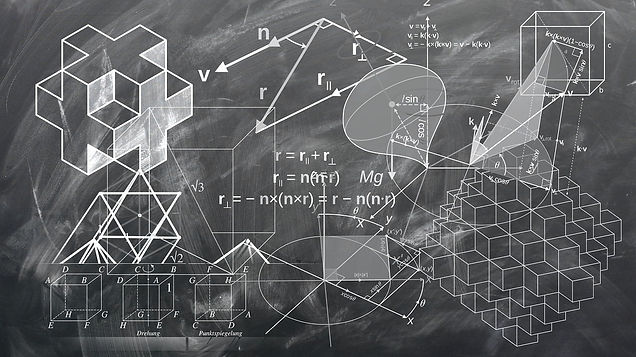
Geometry
Geometry is a foundational mathematics course that explores the principles of Euclidean geometry. This course focuses on the study of two-dimensional and three-dimensional shapes, as well as the relationships between them. Students will learn to think critically, solve geometric problems, and develop logical reasoning skills.
Outline
Geometry explores postulates and theorems of plane and solid geometry, parallel and perpendicular lines, polygons, and congruent and similar triangles. This course covers special right triangle relationships, trigonometric ratios, circles, area and volume, logic training, conditional statements and writing various forms of proofs. The curriculum emphasizes algebraic and practical applications of geometry, proofs, and calculations based on geometric properties.
Books:
/
기하학은 평면 기하학과 입체 기하학의 가정과 정리, 평행선과 수직선, 다각형, 그리고 동형 삼각형과 일치하는 삼각형을 탐구합니다. 이 과목은 특수 직각 삼각형의 관계, 삼각비, 원, 면적과 부피, 논리 훈련, 조건문, 그리고 다양한 종류의 증명 작성을 다룹니다. 교육과정은 기하학적 성질을 기반으로 한 대수적 및 실용적 응용, 증명 및 계산을 강조합니다.
Key Topics Covered:
-
Points, Lines, and Angles: Students will study the basic building blocks of geometry, including points, lines, line segments, rays, and various types of angles (e.g., acute, obtuse, right, and straight angles).
-
Triangles: Triangles are a central theme in geometry. Students will explore different types of triangles (e.g., equilateral, isosceles, scalene), triangle congruence, and the properties of triangles, including the Pythagorean theorem.
-
Quadrilaterals: This section covers the properties of quadrilaterals such as rectangles, squares, parallelograms, rhombuses, and trapezoids.
-
Circles: Students will learn about the properties of circles, including the relationships between angles and arcs, the circumference, and area.
-
Area and Perimeter: The course covers how to calculate the area and perimeter of various geometric shapes, including polygons and circles.
-
Transformations: Students will study transformations like translations, reflections, rotations, and dilations and their effects on geometric figures.
-
Coordinate Geometry: This section introduces students to coordinate systems and how to work with coordinates to solve geometric problems.
-
Three-Dimensional Geometry: Students will explore the properties of three-dimensional shapes such as prisms, pyramids, cylinders, cones, and spheres.
-
Geometric Proofs: An emphasis is placed on geometric reasoning and proofs, where students learn to justify their mathematical conclusions using deductive reasoning.
-
Applications: Throughout the course, students will apply geometric concepts to solve real-world problems, including geometry in architecture, engineering, and design.
/
1. 점, 선, 각: 학생들은 기하학의 기본 구성 요소인 점, 선, 선분, 광선 및 다양한 유형의 각도 (예: 예각, 둔각, 직각 및 직선 각)을 공부할 것입니다.
2. 삼각형: 삼각형은 기하학에서 중요한 주제입니다. 학생들은 다양한 유형의 삼각형 (예: 정삼각형, 이등변 삼각형, 부등변 삼각형), 삼각형 동일성 및 삼각형의 속성, 피타고라스 정리를 탐구할 것입니다.
3. 사각형: 이 섹션에서는 직사각형, 정사각형, 평행사변형, 마름모 및 사다리꼴과 같은 사각형의 속성을 다룹니다.
4. 원: 학생들은 원의 속성, 각도와 호(arc) 간의 관계, 둘레 및 면적에 대해 배울 것입니다.
5. 면적과 둘레: 이 과정에서는 다각형 및 원과 같은 다양한 기하학적 모양의 면적과 둘레를 계산하는 방법을 다룹니다.
6. 변형: 학생들은 변환(translation), 반사(reflection), 회전(rotation) 및 확대(dilation)와 같은 변형을 공부하고 이러한 변형이 기하학적 도형에 미치는 영향을 배울 것입니다.
7. 좌표 기하학: 이 섹션에서는 학생들을 좌표 체계에 소개하고 좌표를 사용하여 기하학적 문제를 해결하는 방법을 가르칩니다.
8. 삼차원 기하학: 학생들은 프리즘, 피라미드, 원통, 원뿔 및 구와 같은 삼차원 도형의 속성을 탐구할 것입니다.
9. 기하학적 증명: 기하학적 추론과 증명에 중점을 두어 학생들은 추론적인 논리를 사용하여 수학적 결론을 정당화하는 방법을 배울 것입니다.
10. 응용: 이 과정을 통해 학생들은 건축, 공학 및 디자인을 포함한 실제 세계 문제를 해결하기 위해 기하학적 개념을 적용할 것입니다.